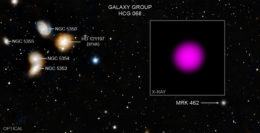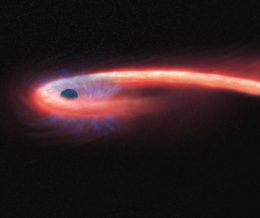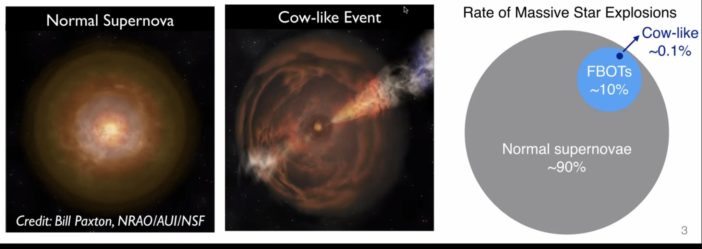Editor’s Note: This week we’re reporting on the virtual programming related to the canceled 239th AAS Meeting. Along with a team of authors from Astrobites, we will be writing updates on selected events at the meeting and posting each day. Follow along here or at astrobites.com. The usual posting schedule for AAS Nova will resume on January 18.
Welcome to the Astrobites coverage of virtual events based around the canceled American Astronomical Society (AAS) meeting! We will report on highlights from each day here, from AAS Press Conferences to grassroots astronomy community meet-ups. If you’d like to see more timely updates during the day, we encourage you to search the #aas239 hashtag on twitter. We’ll be posting once a day during the week, so be sure the visit the site often to catch all the news!
Press Conference: Galaxies & Quasars (by Graham Doskoch)
The first press conference of AAS 239 focused on galaxies and quasars, exploring topics ranging from the early universe to galaxies very similar to the present-day Milky Way. Jessica Sutter (Universities Space Research Association and the Stratospheric Observatory for Infrared Astronomy) presented mapping of ionized carbon in NGC 7331, a “twin” of the Milky Way. This [CII] emission provides a way for the interstellar medium to cool, balancing heating from hot, young O and B stars. However, the [CII] signal is affected by the region of origin, meaning that the inclination of the galaxy in question can impact observations. Press release
Next to speak was graduate student Yuanze Luo (Johns Hopkins University), who discussed the mechanisms behind quenching. “Quenching” refers to processes where a galaxy’s star formation rate decreases, largely due to a loss of interstellar gas. A central supermassive black hole may be the culprit in some cases. Luo’s team used multiwavelength observations to map the structure of the galaxy IC 860. The results showed that the galaxy had a third spiral arm, hot blue stars and potentially a central active galactic nucleus, all of which indicate it was transitioning toward quenching. The team also observed outflows, but they were too weak to actually provide a way for the galaxy to lose gas.

Though the dwarf galaxy Markarian 462 is smaller than the other galaxies in this image, it was the unlikely source of copious amounts of X-rays. Click to enlarge. [X-ray: NASA/CXC/Dartmouth Coll./J. Parker & R. Hickox; Optical/IR: Pan-STARRS]
Mallory Molina (Montana State University) explored the problem from a different angle. They used a novel method of distinguishing SMBH emission from surrounding stellar emission: a spectral line known as the coronal [Fe X] line from outflows surrounding the black hole. As discussed in an Astrobite from last fall, they searched through 40,000 candidates and found SMBHs in 81 of them — all in blue galaxies with young stars. This is unlike most of the known dwarf galaxies hosting SMBHs, which are largely without star formation. This means that the coronal [Fe X] line provides a way to search for a previously unknown population of SMBHs in star-forming dwarf galaxies. Press release
Live-tweeting of the session by Graham Doskoch.
Press Conference: Black Holes & Transient Phenomena (by Briley Lewis)

A SpaceX Falcon 9 rocket launches with NASA’s Imaging X-ray Polarimetry Explorer (IXPE) spacecraft onboard from Launch Complex 39A, Thursday, Dec. 9, 2021, at NASA’s Kennedy Space Center in Florida. [NASA/Joel Kowsky]

Illustration of a tidal disruption event, in which a star is torn apart by a black hole’s gravitational forces and its material falls onto the black hole. [NASA/CXC/M. Weiss]
Finally, graduate student Yuhan Yao (Caltech) rounded out the press conference by telling us about yet another exciting new class of objects: Cow-like supernovae. These are named after AT2018cow (the “Cow supernova”), an exceptionally bright optical supernova discovered a few years ago, which was 10 times brighter than a typical supernova and seen across the entire electromagnetic spectrum. Only four similar objects, known as Cow-like supernovae, were previously known — but today, Yao announced a new one!

Artist’s renditions of normal and cow-like supernovae, describing the difference where Cow-like Events have active central engines. A diagram on the right details how rare Cow-like events are. [Yuhan Yao/Bill Paxton/NRAO/AUI/NSF]
Live-tweeting of the session by Briley Lewis.
